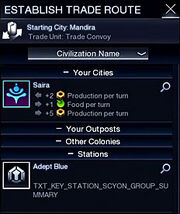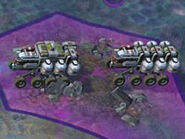
Trade routes can be established between Cities, Outposts, and Stations. They allow those on both end of the trading to receive a bonus of food, energy, production, culture, or science. The trade route generates that bonus by itself, the resources are taken away from nobody. In other words, both parties can only win.
When establishing a trade route, the user interface lists those destinations that are reachable from the current origin city. A trade route must be completely explored (i.e. have no fog of war to cover it) and it must not have any Miasma on it (unless you have either 6 Harmony points or researched Alien Hybridization). Other than that, there are no limitations on, say, the length of a trade route. In the trade route screen you see the destinations have little arrows below them, listing the resources the route would generate. The ![]() left arrow means imports and the
left arrow means imports and the ![]() right arrow means exports. In other words,
right arrow means exports. In other words, ![]() left is what the origin city would get,
left is what the origin city would get, ![]() right is what the destination city would get.
right is what the destination city would get.
Trade routes are vulnerable to attack. If you are at war with someone who might attack them, or have hostile aliens appearing along them, then you may need to have military units ready to send out to deal with any problems. The Ultrasonic Fence can also protect Trade Routes from all alien attacks when upgraded through a quest.
Stations are like city-states in other Civilization games. There are different materials and bonuses they can provide you with.
Trade routes are established by the Trade Convoy units for land routes, and by Trade Vessel units for sea routes.
Trade routes can be improved by the following buildings:
- Feedsite Hub +1
 Science from international City or Station Trade Routes.
Science from international City or Station Trade Routes. - Autoplant +1
 Energy from international City or Station Trade Routes.
Energy from international City or Station Trade Routes. - Recycler +1
 Production from internal City or Station Trade Routes.
Production from internal City or Station Trade Routes.
Polystralia receives two extra trade routes in its capital city.
The number of trade routes available increases with the city's population: 10, 22, 34, 48, 62, 78, 94, 112 and so on (every second plus add another 2 turns).




